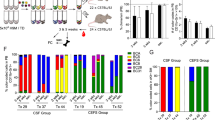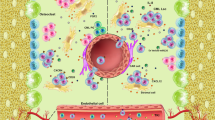Abstract
Cancer stem cells have been proposed to be important for initiation, maintenance and recurrence of various malignancies, including acute myeloid leukemia (AML)1,2,3. We have previously reported4 that CD34+CD38− human primary AML stem cells residing in the endosteal region of the bone marrow are relatively chemotherapy resistant. Using a NOD/SCID/IL2rγnull mouse model of human AML, we now show that the AML stem cells in the endosteal region are cell cycle quiescent and that these stem cells can be induced to enter the cell cycle by treatment with granulocyte colony-stimulating factor (G-CSF). In combination with cell cycle-dependent chemotherapy, G-CSF treatment significantly enhances induction of apoptosis and elimination of human primary AML stem cells in vivo. The combination therapy leads to significantly increased survival of secondary recipients after transplantation of leukemia cells compared with chemotherapy alone.
This is a preview of subscription content, access via your institution
Access options
Subscribe to this journal
Receive 12 print issues and online access
$209.00 per year
only $17.42 per issue
Buy this article
- Purchase on Springer Link
- Instant access to full article PDF
Prices may be subject to local taxes which are calculated during checkout



Similar content being viewed by others
References
Bonnet, D. & Dick, J.E. Human acute myeloid leukemia is organized as a hierarchy that originates from a primitive hematopoietic cell. Nat. Med. 3, 730–737 (1997).
Jordan, C.T., Guzman, M.L. & Noble, M. Cancer stem cells. N. Engl. J. Med. 355, 1253–1261 (2006).
Lapidot, T. et al. A cell initiating human acute myeloid leukaemia after transplantation into SCID mice. Nature 367, 645–648 (1994).
Ishikawa, F. et al. Chemotherapy-resistant human AML stem cells home to and engraft within the bone-marrow endosteal region. Nat. Biotechnol. 25, 1315–1321 (2007).
Estey, E. & Dohner, H. Acute myeloid leukaemia. Lancet 368, 1894–1907 (2006).
Dick, J.E. Stem cell concepts renew cancer research. Blood 112, 4793–4807 (2008).
Clarke, M.F. et al. Cancer stem cells–perspectives on current status and future directions: AACR Workshop on cancer stem cells. Cancer Res. 66, 9339–9344 (2006).
Lapidot, T. & Petit, I. Current understanding of stem cell mobilization: the roles of chemokines, proteolytic enzymes, adhesion molecules, cytokines, and stromal cells. Exp. Hematol. 30, 973–981 (2002).
Wilson, A. et al. Hematopoietic stem cells reversibly switch from dormancy to self-renewal during homeostasis and repair. Cell 135, 1118–1129 (2008).
Sugiyama, T., Kohara, H., Noda, M. & Nagasawa, T. Maintenance of the hematopoietic stem cell pool by CXCL12-CXCR4 chemokine signaling in bone marrow stromal cell niches. Immunity 25, 977–988 (2006).
Sipkins, D.A. et al. In vivo imaging of specialized bone marrow endothelial microdomains for tumour engraftment. Nature 435, 969–973 (2005).
Conneally, E., Cashman, J., Petzer, A. & Eaves, C. Expansion in vitro of transplantable human cord blood stem cells demonstrated using a quantitative assay of their lympho-myeloid repopulating activity in nonobese diabetic-scid/scid mice. Proc. Natl. Acad. Sci. USA 94, 9836–9841 (1997).
Wang, J.C., Doedens, M. & Dick, J.E. Primitive human hematopoietic cells are enriched in cord blood compared with adult bone marrow or mobilized peripheral blood as measured by the quantitative in vivo SCID-repopulating cell assay. Blood 89, 3919–3924 (1997).
Smith, T.J. et al. 2006 update of recommendations for the use of white blood cell growth factors: an evidence-based clinical practice guideline. J. Clin. Oncol. 24, 3187–3205 (2006).
Jorgensen, H.G. et al. Intermittent exposure of primitive quiescent chronic myeloid leukemia cells to granulocyte-colony stimulating factor in vitro promotes their elimination by imatinib mesylate. Clin. Cancer Res. 12, 626–633 (2006).
te Boekhorst, P.A., Lowenberg, B., Vlastuin, M. & Sonneveld, P. Enhanced chemosensitivity of clonogenic blasts from patients with acute myeloid leukemia by G-CSF, IL-3 or GM-CSF stimulation. Leukemia 7, 1191–1198 (1993).
Lowenberg, B. et al. Effect of priming with granulocyte colony-stimulating factor on the outcome of chemotherapy for acute myeloid leukemia. N. Engl. J. Med. 349, 743–752 (2003).
Amadori, S. et al. Use of glycosylated recombinant human G-CSF (lenograstim) during and/or after induction chemotherapy in patients 61 years of age and older with acute myeloid leukemia: final results of AML-13, a randomized phase-3 study. Blood 106, 27–34 (2005).
Buchner, T., Berdel, W.E. & Hiddemann, W. Priming with granulocyte colony-stimulating factor–relation to high-dose cytarabine in acute myeloid leukemia. N. Engl. J. Med. 350, 2215–2216 (2004).
Estey, E.H. et al. Randomized phase II study of fludarabine + cytosine arabinoside + idarubicin +/− all-trans retinoic acid +/− granulocyte colony-stimulating factor in poor prognosis newly diagnosed acute myeloid leukemia and myelodysplastic syndrome. Blood 93, 2478–2484 (1999).
Milligan, D.W., Wheatley, K., Littlewood, T., Craig, J.I. & Burnett, A.K. Fludarabine and cytosine are less effective than standard ADE chemotherapy in high-risk acute myeloid leukemia, and addition of G-CSF and ATRA are not beneficial: results of the MRC AML-HR randomized trial. Blood 107, 4614–4622 (2006).
Ohno, R. et al. A double-blind controlled study of granulocyte colony-stimulating factor started two days before induction chemotherapy in refractory acute myeloid leukemia. Kohseisho Leukemia Study Group. Blood 83, 2086–2092 (1994).
Mori, T. et al. Long-term follow-up of allogeneic hematopoietic stem cell transplantation for de novo acute myelogenous leukemia with a conditioning regimen of total body irradiation and granulocyte colony-stimulating factor-combined high-dose cytarabine. Biol. Blood Marrow Transplant. 14, 651–657 (2008).
Ooi, J. et al. Unrelated cord blood transplantation for adult patients with de novo acute myeloid leukemia. Blood 103, 489–491 (2004).
Ishikawa, F. et al. Development of functional human blood and immune systems in NOD/SCID/IL2 receptor γ chain(null) mice. Blood 106, 1525–1573 (2005).
Viale, A. et al. Cell-cycle restriction limits DNA damage and maintains self-renewal of leukaemia stem cells. Nature 457, 51–56 (2009).
Matsunaga, T. et al. Interaction between leukemic-cell VLA-4 and stromal fibronectin is a decisive factor for minimal residual disease of acute myelogenous leukemia. Nat. Med. 9, 1158–1165 (2003).
Christopher, M.J., Liu, F., Hilton, M.J., Long, F. & Link, D.C. Suppression of CXCL12 production by bone marrow osteoblasts is a common and critical pathway for cytokine-induced mobilization. Blood 114, 1331–1339 (2009).
Fukuda, S., Bian, H., King, A.G. & Pelus, L.M. The chemokine GRObeta mobilizes early hematopoietic stem cells characterized by enhanced homing and engraftment. Blood 110, 860–869 (2007).
Zeng, Z. et al. Targeting the leukemia microenvironment by CXCR4 inhibition overcomes resistance to kinase inhibitors and chemotherapy in AML. Blood 113, 6215–6224 (2009).
Nervi, B. et al. Chemosensitization of AML following mobilization by the CXCR4 antagonist AMD3100. Blood 113, 6206–6214 (2009).
Sato, T. et al. Interferon regulatory factor-2 protects quiescent hematopoietic stem cells from type I interferon-dependent exhaustion. Nat. Med. 15, 696–700 (2009).
Essers, M.A. et al. IFNα activates dormant haematopoietic stem cells in vivo. Nature 458, 904–908 (2009).
Sipkins, D.A. Rendering the leukemia cell susceptible to attack. N. Engl. J. Med. 361, 1307–1309 (2009).
Jin, L. et al. Monoclonal antibody-mediated targeting of CD123, IL-3 receptor alpha chain, eliminates human acute myeloid leukemic stem cells. Cell Stem Cell 5, 31–42 (2009).
Majeti, R. et al. CD47 is an adverse prognostic factor and therapeutic antibody target on human acute myeloid leukemia stem cells. Cell 138, 286–299 (2009).
Saito, Y. et al. Identification of therapeutic targets for quiescent, chemotherapy-resistant human leukemia stem cells. Sci. Transl. Med. 2, 17ra9 (2010).
Acknowledgements
We thank T. Tanaka and M. Yamaguchi for assistance with confocal microscopy. We thank T. Kanabayashi for assistance with histological studies. We thank M. Narita for assistance with patient data collection. This work was supported through grants from the Ministry of Education, Culture, Sports, Science and Technology-Japan, National Institute of Biomedical Innovation, Takeda Science Foundation and Uehara Memorial Foundation to F.I. and National Institutes of Health grant CA20408 to L.D.S.
Author information
Authors and Affiliations
Contributions
Y.S., L.D.S. and F.I. designed the study, analyzed the data and wrote the manuscript. N.U., A.W. and S. Taniguchi provided clinical samples, information and discussion. Y.S., S. Tanaka, M.T.-M., N.S., A.S. and F.I. performed the experiments. S. Takagi and Y.A. analyzed the data. Y.N. analyzed the data and wrote the manuscript.
Corresponding author
Ethics declarations
Competing interests
The authors declare no competing financial interests.
Supplementary information
Supplementary Text and Figures
Supplementary Figs. 1–5 and Supplementary Tables 1–5 (PDF 9230 kb)
Supplementary Movie 1
This movie shows a cross-sectional view through a three-dimensional reconstruction of the recipient femur shown in Fig. 2j. The bone section was labeled for human CD45 (red), Ki67 (green) and DAPI (blue). The serial cross-sectional images along the long axis of the bone demonstrate that there is little to no Ki67 expression by hCD45+DAPI+ AML cells in the BM endosteal region adjacent to the bone at baseline. (MOV 8927 kb)
Supplementary Movie 2
This movie shows a cross-sectional view through a three-dimensional reconstruction of the recipient femur shown in Fig. 2k. The bone section was labeled for human CD45 (red), Ki67 (green) and DAPI (blue). The serial cross-sectional images along the long axis of the bone demonstrate the appearance of Ki67+hCD45+DAPI+ cells within the BM endosteal region following G-CSF treatment. (MOV 7826 kb)
Rights and permissions
About this article
Cite this article
Saito, Y., Uchida, N., Tanaka, S. et al. Induction of cell cycle entry eliminates human leukemia stem cells in a mouse model of AML. Nat Biotechnol 28, 275–280 (2010). https://doi.org/10.1038/nbt.1607
Received:
Accepted:
Published:
Issue Date:
DOI: https://doi.org/10.1038/nbt.1607
This article is cited by
-
Cardiac glycoside ouabain efficiently targets leukemic stem cell apoptotic machinery independent of cell differentiation status
Cell Communication and Signaling (2023)
-
Exosomal DEK removes chemoradiotherapy resistance by triggering quiescence exit of breast cancer stem cells
Oncogene (2022)
-
In vivo anti-tumor effect of PARP inhibition in IDH1/2 mutant MDS/AML resistant to targeted inhibitors of mutant IDH1/2
Leukemia (2022)
-
Current challenges in metastasis research and future innovation for clinical translation
Clinical & Experimental Metastasis (2022)
-
Long-term outcomes following the addition of granulocyte colony-stimulating factor-combined high-dose cytarabine to total body irradiation and cyclophosphamide conditioning in single-unit cord blood transplantation for myeloid malignancies
Annals of Hematology (2022)



